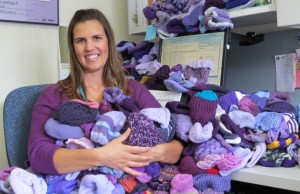
For months, Amy Owens has been seeing purple.
Little, hand-knitted purple caps are overflowing from giant bags in the Protection, Advocacy and Outreach Program office at Seattle Children’s, where she is senior program coordinator. Hats are spilling out of cabinets, covering her keyboard and peeking out of overstuffed envelopes under her desk.
By the end of November, each of these 3,600-plus purple hats will be cradling the head of a newborn at a birthing hospital in Washington state.
The hats will remind their parents that it’s normal for babies to cry – and often, there is nothing a parent can do to stop it.
Research shows that prolonged, unrelenting crying is the number one reason parents (and other caregivers) shake a baby. Research also shows that simply understanding the normal pattern of infant crying and learning a few coping skills significantly reduces the likelihood that a child will be shaken or abused.
Thanks to the Protection, Advocacy and Outreach Program team at Children’s, parents of newborns in Washington are learning about crying and coping before they leave the hospital through a video-based training program called “Period of PURPLE Crying.”
The PURPLE training, developed and tested by the National Center on Shaken Baby Syndrome, aims to reduce shaken baby syndrome and other traumatic injuries in infants that occur when frustrated, sleep-deprived parents lose control with a wailing baby.
“The point isn’t to stop parents from getting frustrated – that’s inevitable,” said Amy. “Rather, it’s to help parents plan in advance how they’ll keep their babies safe when their own emotions are running high.”
Task force takes on a growing problem
“In 2008, soon after the recession started, there was a significant spike in cases of abusive head trauma across the nation, and we felt it here,” said Amy. “That’s when we shifted gears to address this in a systematic way.”
The Protection, Advocacy and Outreach team, led by Carol Jenkins, program manager, gathered public health professionals, hospital social workers, law enforcement representatives and others from King County and across the state to create the Abusive Head Trauma Prevention Task Force.
Through the task force, Children’s has led statewide outreach efforts to reach birthing hospitals, introducing them to the PURPLE training and encouraging them to adopt it. Almost half of them have, and that number keeps climbing.
The effort launched in October 2010, when Children’s and the task force hosted a community conference featuring experts from the National Center on Shaken Baby Syndrome. That’s where Nicole Roehrig, pediatric clinical nurse specialist at Swedish Medical Center, had her “aha!” moment.
Every new parent learns PURPLE
“The training they were proposing totally made sense,” said Nicole. “We asked our Swedish Foundation to fund it that year as a pilot. They did, and we’ve written it into our budget every year since.”
Swedish gives parents of every newborn a copy of the DVD and other training materials (that’s between 8,000 and 10,000 per year) and also invests in staff training. That ensures parents hear consistent messages about crying and coping from staff in the prenatal, post-partum, labor and delivery, pediatric, intensive care and emergency departments.
Moms and dads also see fliers at the hospital’s inpatient units, The Lytle Center for Pregnancy and Newborns, classrooms, lactation visits and other places at Swedish they visit for care for their new baby.
PURPLE is paying off, says Nicole. “During our last auditing period, we had no admissions or Emergency Department visits for babies with shaken baby syndrome or intentional head trauma,” she said. “With that information, we feel the PURPLE program is very much worth the cost, time and training.”
Amy and others on her team – who travel statewide to reach out and train hospital staff members – hear similar stories at birthing hospitals from Spokane to Port Townsend, she said.
What’s up with those hats?
In addition to pushing PURPLE, Children’s has adopted another initiative of the National Center for Shaken Baby Syndrome – Click for Babies, a grassroots knitting campaign.
The goal is to put a purple hat on all babies born in November at hospitals in Washington that offer “Period of PURPLE Crying” training. That’s as few as five babies at Whitman Hospital and Medical Center in Colfax, Wash., and as many as 675 at the Swedish’s First Hill campus.
Children’s collects the hats year-round, then washes them and distributes them in November. They come one or two at a time from individual knitters, and in big batches from hospitals and other places that organize kitting efforts.
Want to get involved? Pick up your needles, find some purple yarn and stitch up a hat (you can even find patterns at the Click for Babies website). It’s that easy.
Resources:
- Seattle Children’s Protection Program
- Protection Program Resources
- Helping new parents cope with normal infant crying
- A pledge to help end child abuse – One mother’s story

